AI vs. Human: Half Can’t Spot the Difference!
Table of Contents
At Tattoos.ai, we’re constantly pushing the boundaries of cutting edge technology and creativity. At the same time, we wanted to find out if people could tell a difference between a tattoo that was designed using an AI tattoo generator and one created by professional tattoo artists using a traditional tattoo design process.
So, we decided to conduct a unique experiment. Our survey asked 391 people whether they believed a series of different art images were created by AI tools or by professional tattoo artists.
The results, which we highlight below, reveal fascinating insights into the intersection of advanced technology and image generation, and traditional tattoo artistry.
Overall Performance: A Close Competition in the Design Process with AI Tools
The overall results of our AI tattoo survey highlighted how much more difficult it’s getting for people to differentiate between artificial intelligence and classic human creativity. As the results showed …
- 50.6% of participants identified AI generated tattoos accurately.
- 42.9% incorrectly identified a tattoo designed by a human as designed using an AI tattoo generator, which shows how proficient AI tools are at mimicking tattoo design.
- 6.5% of participants said they weren’t sure, which highlights both the complexity and subtlety of AI generated tattoos.
What these results suggest is that as artificial intelligence evolves even more, it’s going go to become even more difficult to delineate between art created purely by technology and art created by human artists.
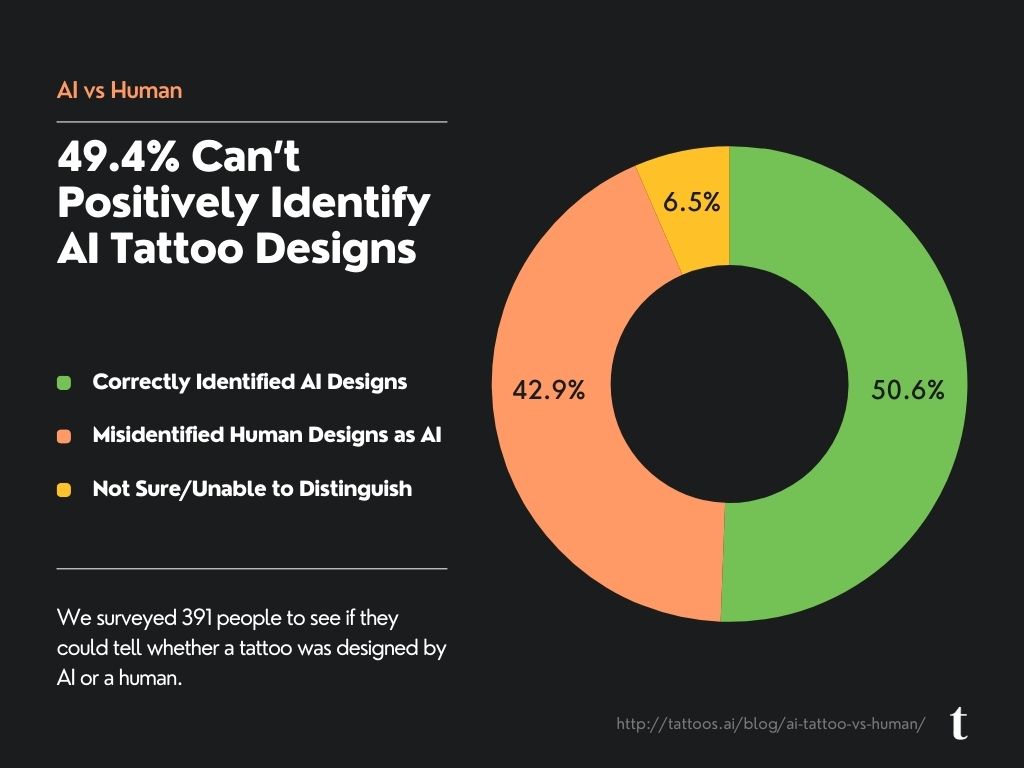
A Gender Difference? Not Much When Discussing An AI Tattoo Generator
Examining results broken down by gender, our survey found there were only minimal differences. This suggests that all gender groups have some difficulty identifying a tattoo design created by an AI tattoo generator compared to by body artists in a tattoo shop…
- Men: A little more than half (51.7%) of men surveyed identified the AI generator tattoos correctly. Of the remaining, 42.1% mistook experienced artists’ designs for those created with AI tools, while 6.1% said they were unsure.
- Women: The results with women were similar — 50.5% successfully identified AI generated body art, 43.4% misidentified, and 6.1% weren’t sure.
- Other: Participants who didn’t identify as either female or male had both a higher rate of uncertainty (10.2%) and a lower rate of accurate identification of AI generated designs (45.6%).
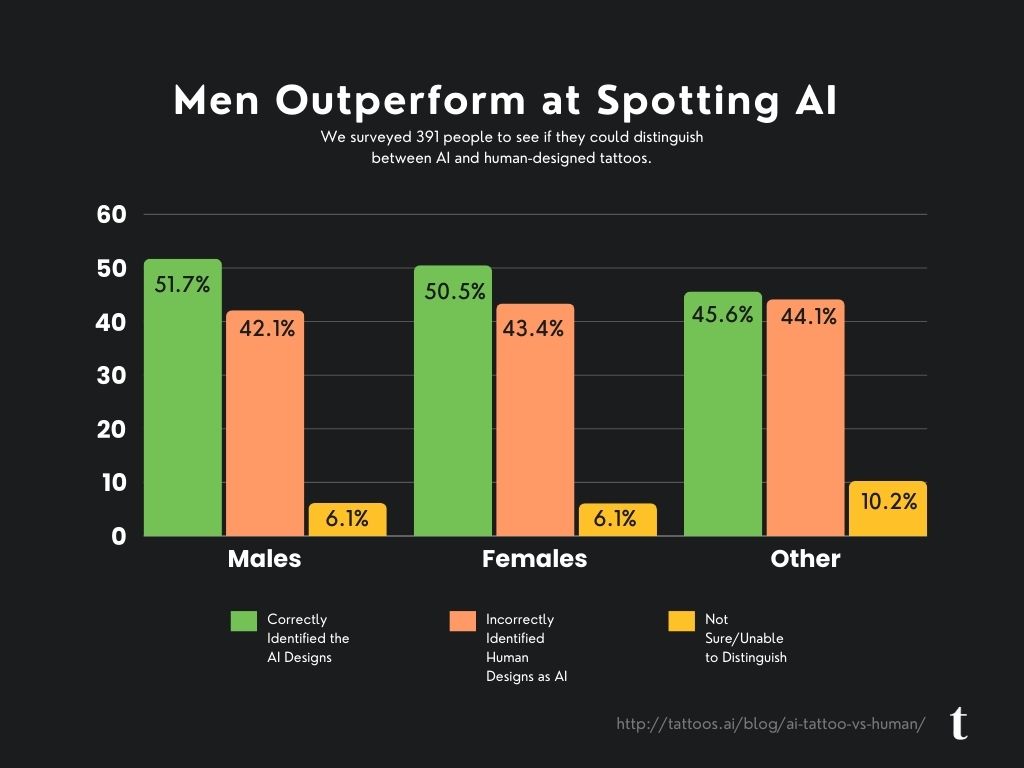
Age Breakdown Reveals Interesting Findings
in our AI Tattoo Study
Our tattoo artistry study revealed some very interesting differences among generations and whether they were able to accurately tell what were AI generated designs and what were tattoo styles designed by experienced artists in the tattoo community.
Much of this suggests that people’s familiarity with AI tools and the seamless integration of how they’re used in the next generation of technology could play an important role in their ability to correctly identify images created by technology tools.
- Under 18: The youngest age cohort was the most accurate at correctly identifying a picture that was generated using a technology tool. Those in this age group correctly identified AI generated tattoos at a rate of 60.4%. This group also was the one least likely to misidentify a human tattoo design by professional tattoo artists as coming from AI tools.
- 18-24: This age group also did well, with 54.3% correctly identifying different tattoo styles as coming from an AI generator. This suggests that the youngest generations are more in tune with digital tools in general and the specific nuances of the intricate details that technology tools can create.
- 25-34: The accuracy dropped a little bit with this “next up” age group, which saw an accuracy rate of 48.5% for a tattoo design coming from an AI tattoo generator. This marks a potential “transitional phase” in terms of age groups, where the lines between tattoo designs from human tattoo artists and image generation from technology alone get blurred.
- 35-44: That downward trend continued in this age group, with 46.1% correctly identifying images that were AI generated versus those created by tattoo artists at a tattoo shop.
- 45-54: The next age group had a 44.7% correct identification rate for AI generated tattoos, which is actually the lowest among all age groups. This cohort mistook tattoo artists’ designs as being created by AI tools at a 45.9% rate.
- 55-64: This age group was the most likely (53.3%) to mistake a tattoo design created by a person experienced in body art as actually created by AI technology. This highlights how difficult it is for older generations to accurately explore a picture and various images to decipher whether it’s created by a traditional human-based creative process or AI tools.
- 65 and above: One very interesting result of our study into the tattoo community is that this oldest age group was just as successful at identifying tattoo designs that used AI as the under-18 age group (60%). Maybe it’s true: The wisdom a person gains over their lifetime can help them better explore and examine different tattoo ideas, even if they have no experience in AI technology and how it’s used in the tattoo industry.
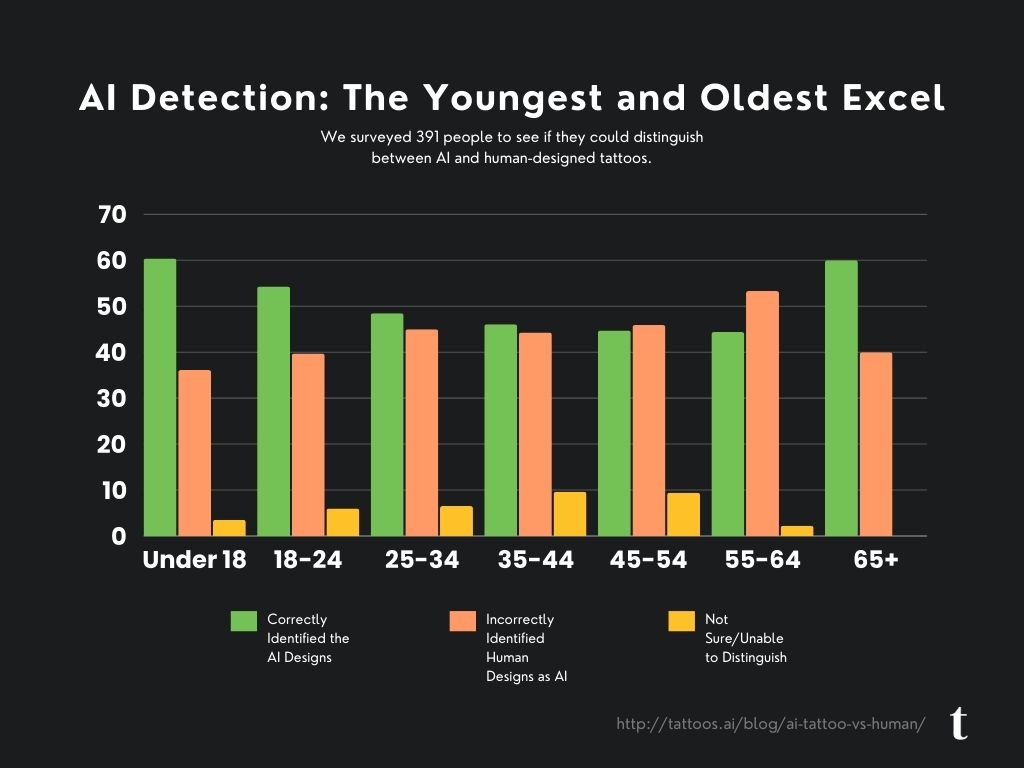
Design Breakdown: Do Certain Styles in the Tattoo Design Process Hold Secrets?
Our tattoo study aimed to explore different aspects of AI generated images that could be used on a person as body art. What we found is that the specific sign of a picture or art in general played a big role in how accurate a person was in correctly identifying images as being generated by AI tools versus a more traditional design process and creative process.
Different tattoo styles, then, play a role in whether a person can tell that a tattoo design was created by experienced tattoo artists or using AI design…
- Realistic Style: AI was very good in this tattoo design style. Participants correctly identified a tattoo as being created by AI art at a 73.5% rate here.
- Minimalist Style: For a minimalist design, participants correctly identified AI generated designs at a 56% rate. This reflects the simplicity and deceptive nature that tattoo artists can use to their advantage with various styles in this art category.
- Retro Style & Surrealism Style: Both the retro and surrealism style of tattoo art saw a correct identification rate of 60.8%. This shows that AI tools could be the future of how images are generated for body art, and that many tattoo artists could use this to achieve their client’s vision.
- Fine-line Style: AI tools show they can product quality work on images with intricate details, as 54.7% of images in this category were identified accurately as being created using an AI device.
- Tribal Style: AI has the ability to create quality images of various styles that pay homage to different cultures around the world, as 51.9% of people correctly identified images in this tattoo category as being generated by an AI design.
- Continuous-line Style: With a success rate of only 46.6%, this style of tattoo design might still be best left up to human tattoo artists with experience in the tattoo industry. It could suggest that AI designed tattoos might not be able to yet deliver the quality needed for these types of images.
- Japanese Style: This other intricate style of images is tougher for AI tools to replicate, with a correct identification rate of only 45.8%. Many tattoo artists would be best left to use their own ideas, services and ability to produce high-quality body art for their clients.
- Watercolor Style: The most challenging tattoo design style was watercolor, as only 34.1% of the people who participated in our survey correctly identified art as being generated by AI. This shows just how complex this style is, and why many artists might still want to rely on their own ability to create these ideas for their clients.
- Traditional Style: One final and yet very surprising result was that the traditional style was only correctly identified at a 21.4% as being created by AI. This shows that this is a style that many artists are simply better at creating using a traditional process for tattoos, rather than relying on AI generated designs.
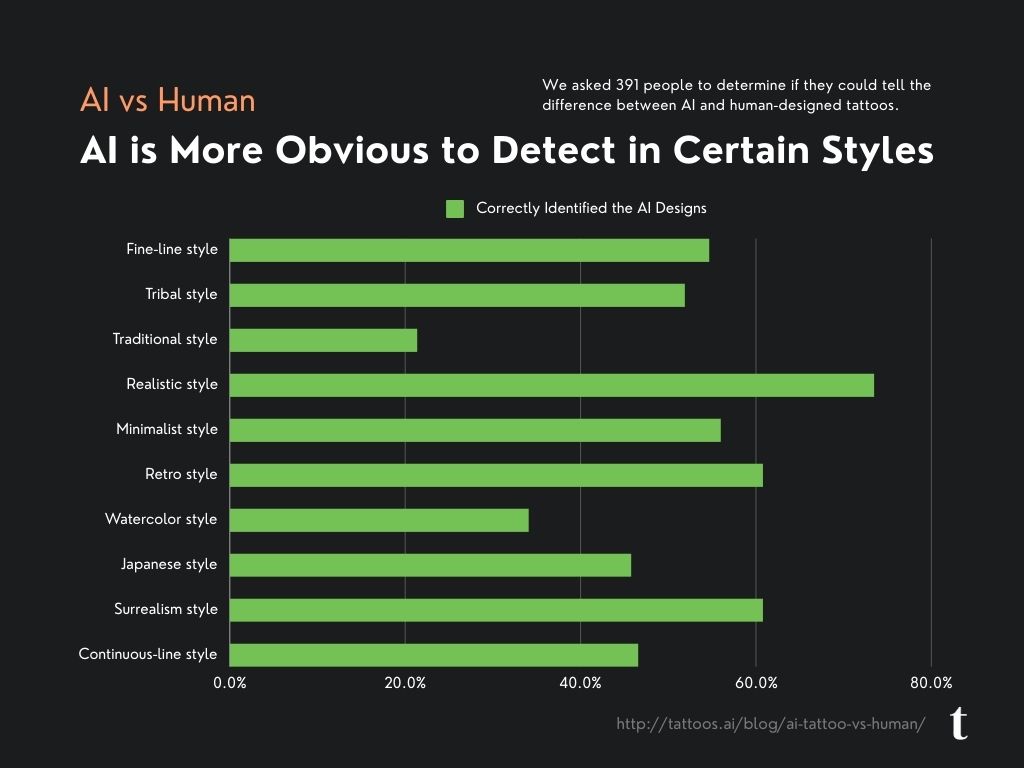
Can You Spot AI generated Designs Versus Those Created by Tattoo Artists?
Survey respondents were presented with the 10 tattoo designs below. Each set includes a design that was created by human tattoo artists and one created by AI tools. Can you tell the difference between the two art images?
Realistic Style:
- Correctly Identified AI: 51%
- Incorrectly Identified Human Designs as AI: 32%
- Not Sure: 17%
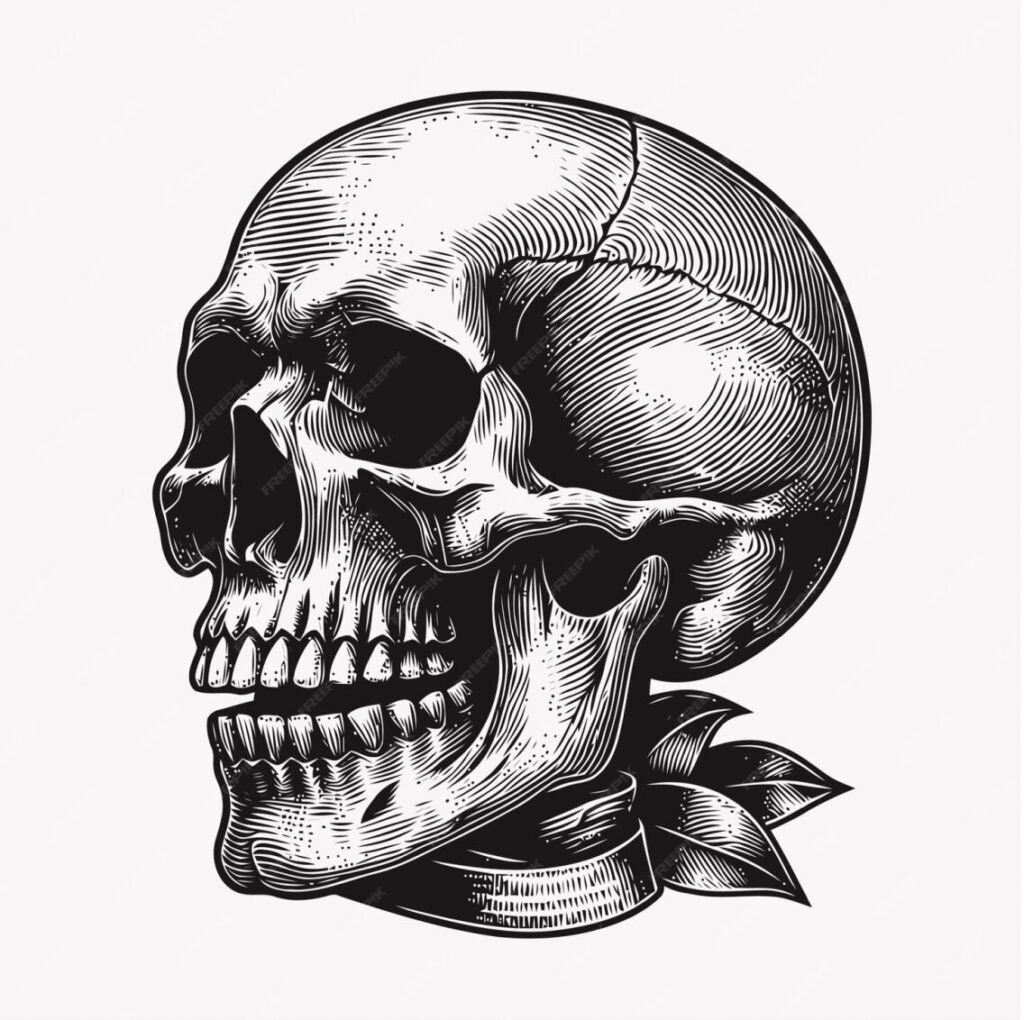
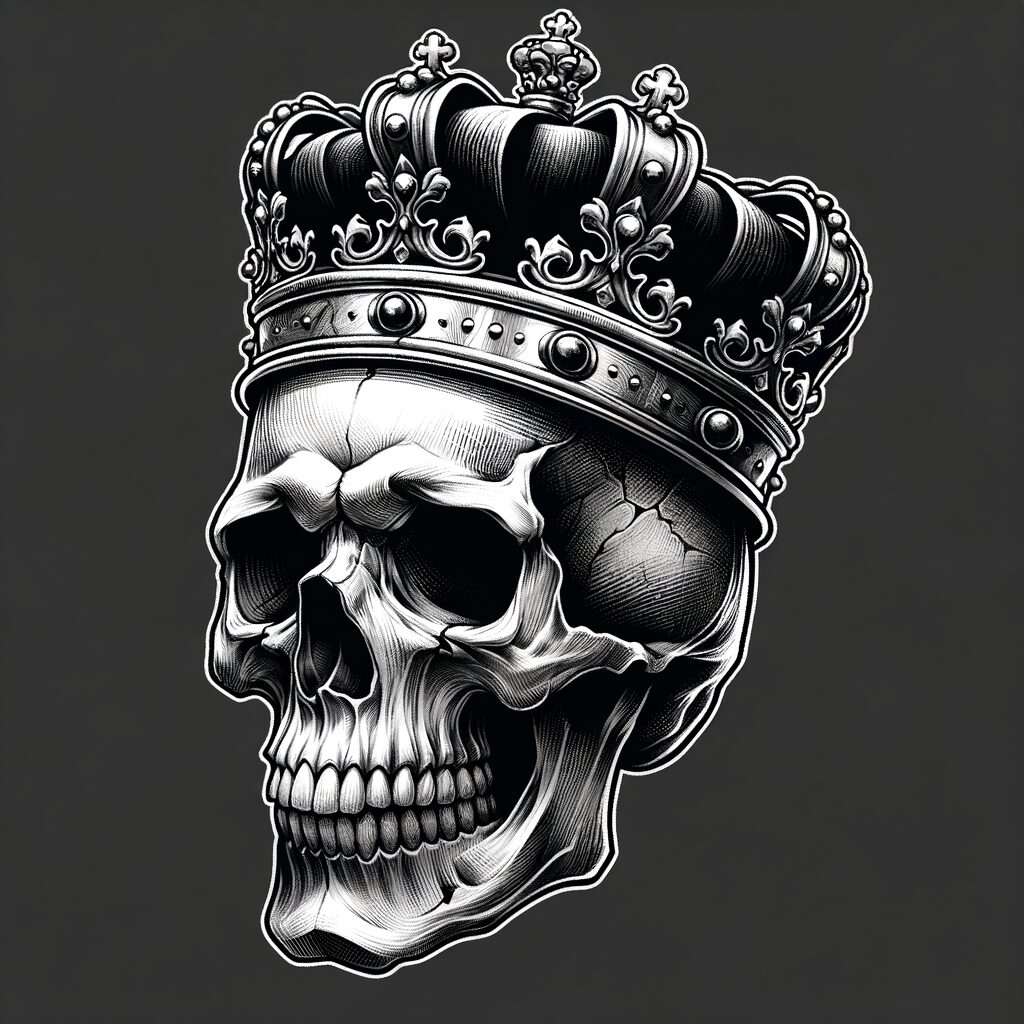
Continuous line Style:
- Correctly Identified AI: 51%
- Incorrectly Identified Human Designs as AI: 32%
- Not Sure: 17%
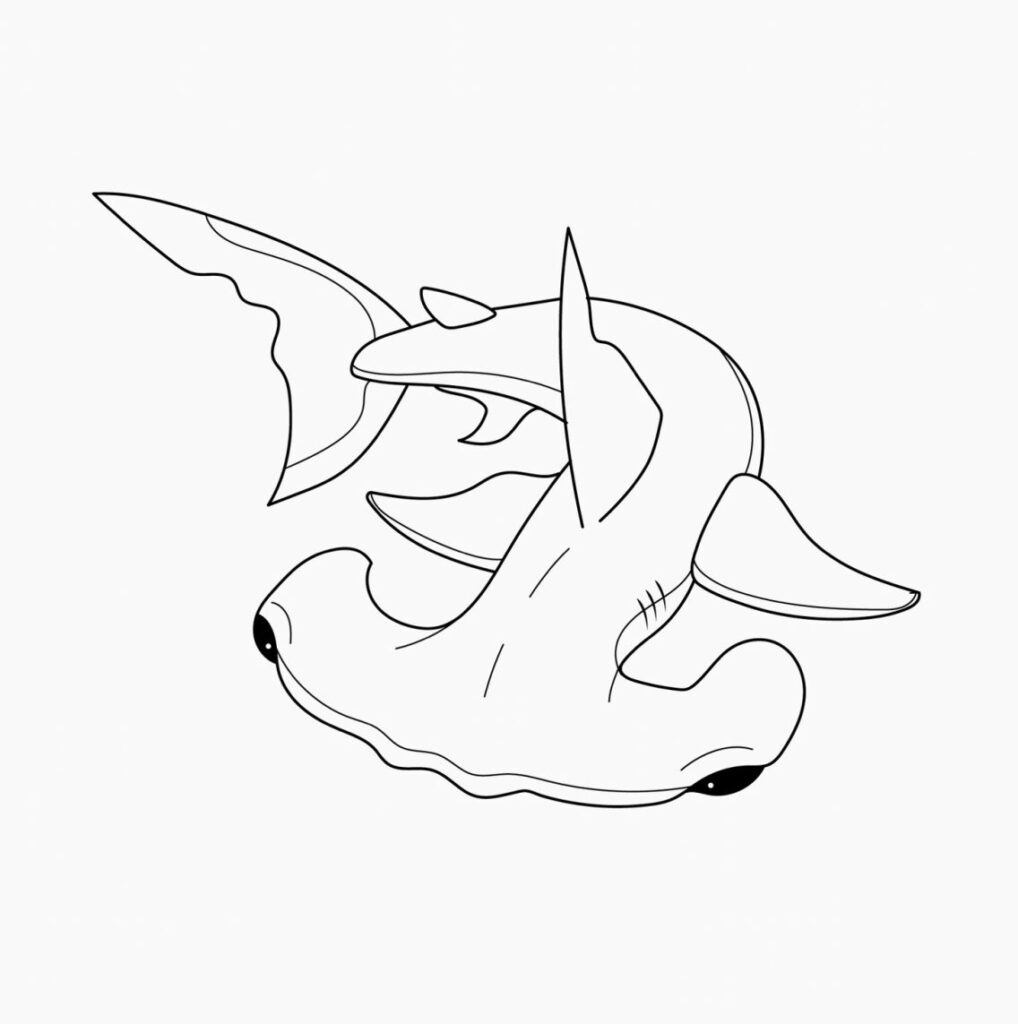
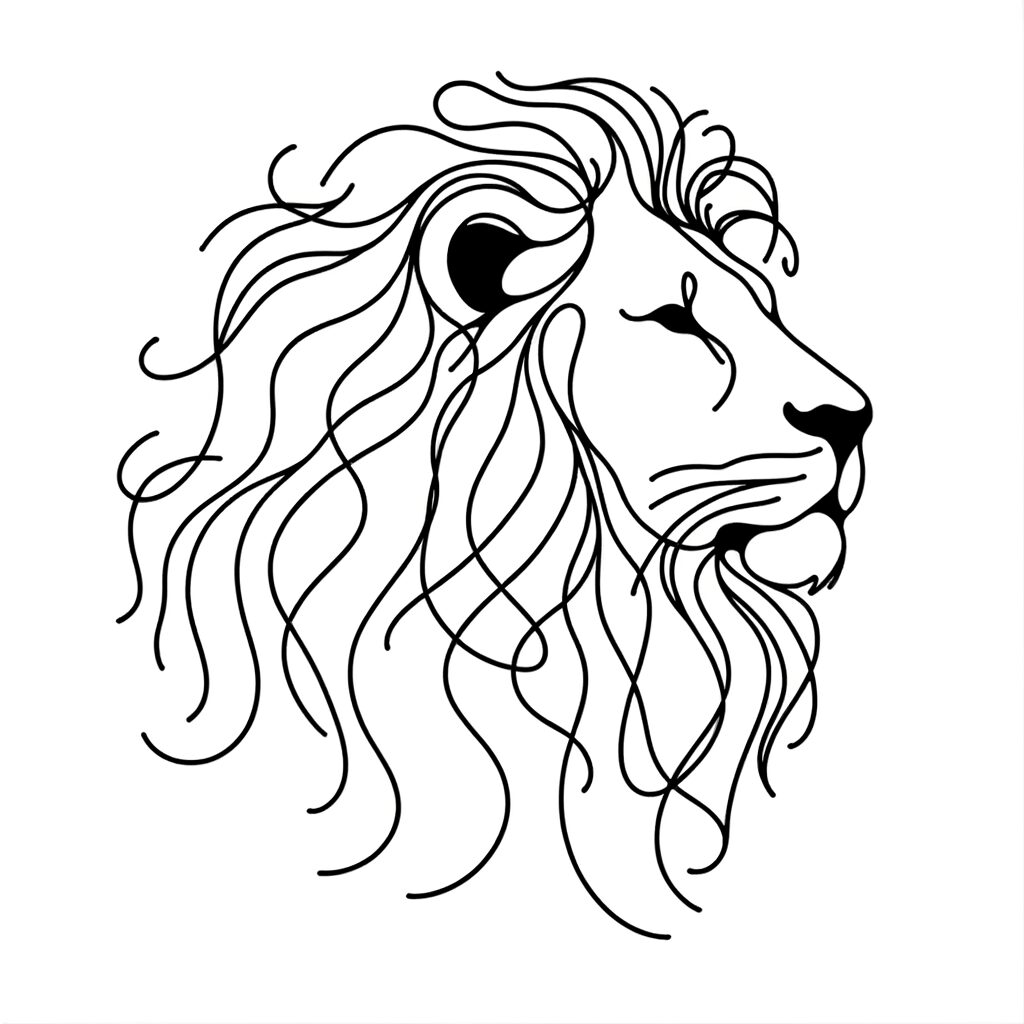
Tribal Style:
- Correctly Identified AI: 51%
- Incorrectly Identified Human Designs as AI: 32%
- Not Sure: 17%
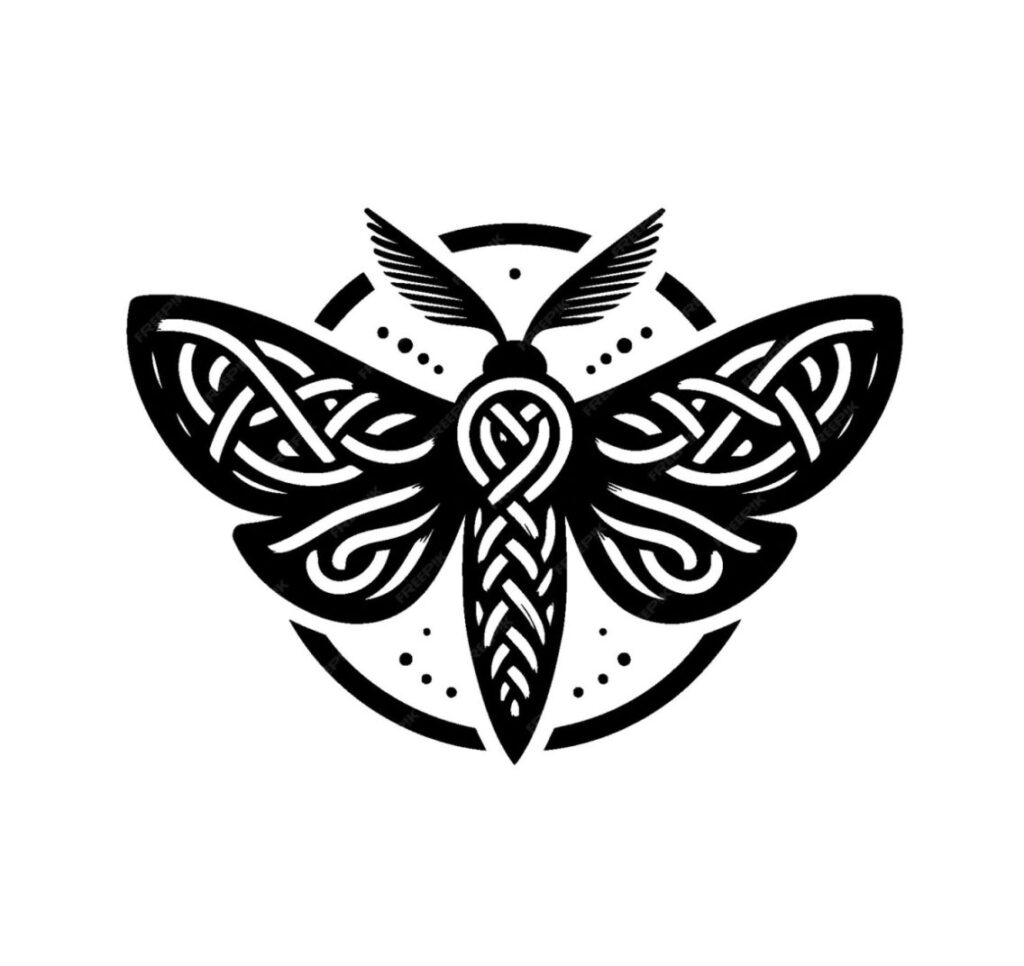
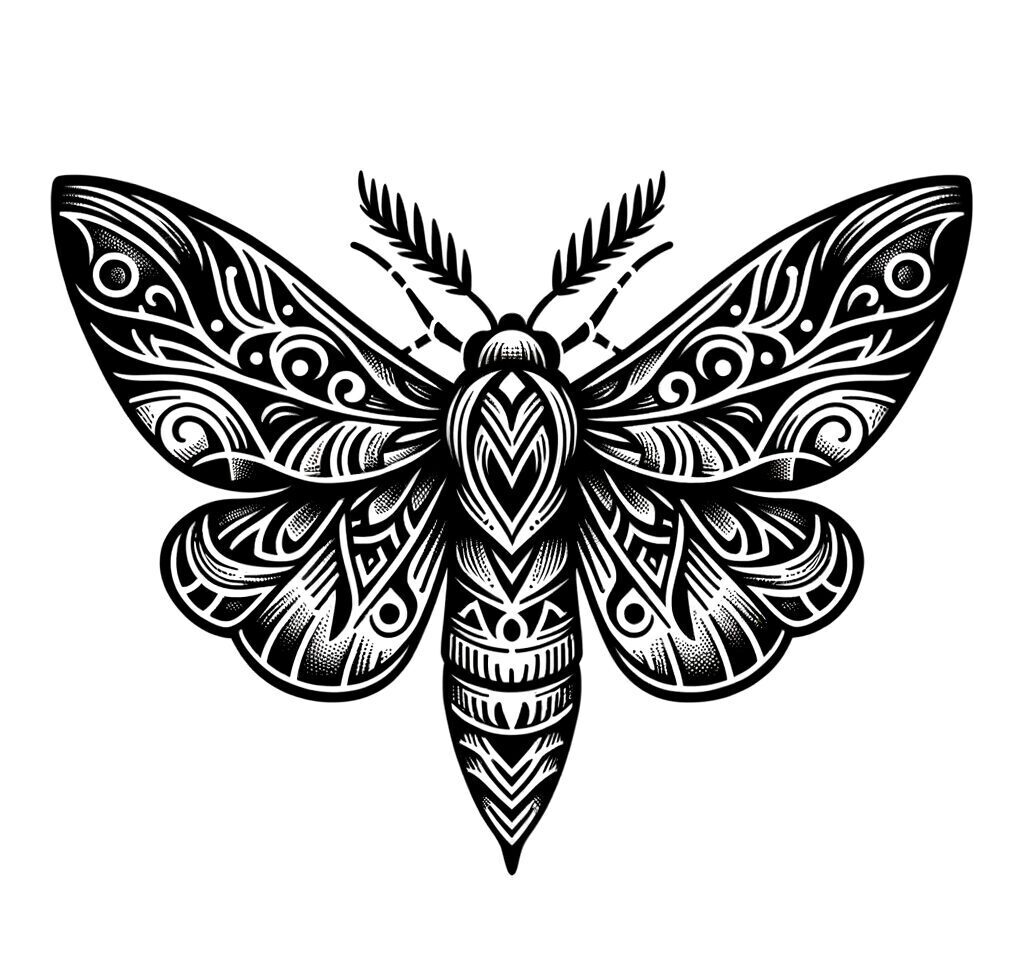
Watercolor Style:
- Correctly Identified AI: 51%
- Incorrectly Identified Human Designs as AI: 32%
- Not Sure: 17%
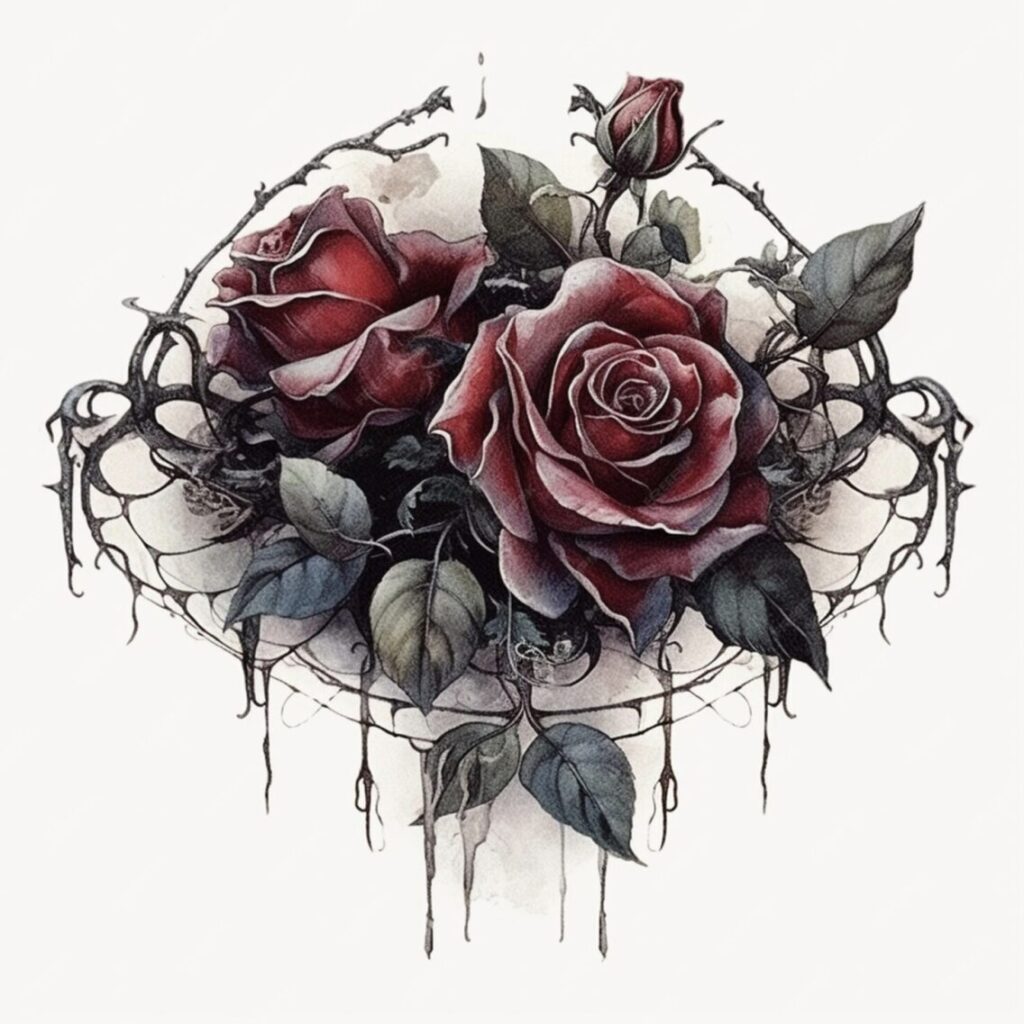
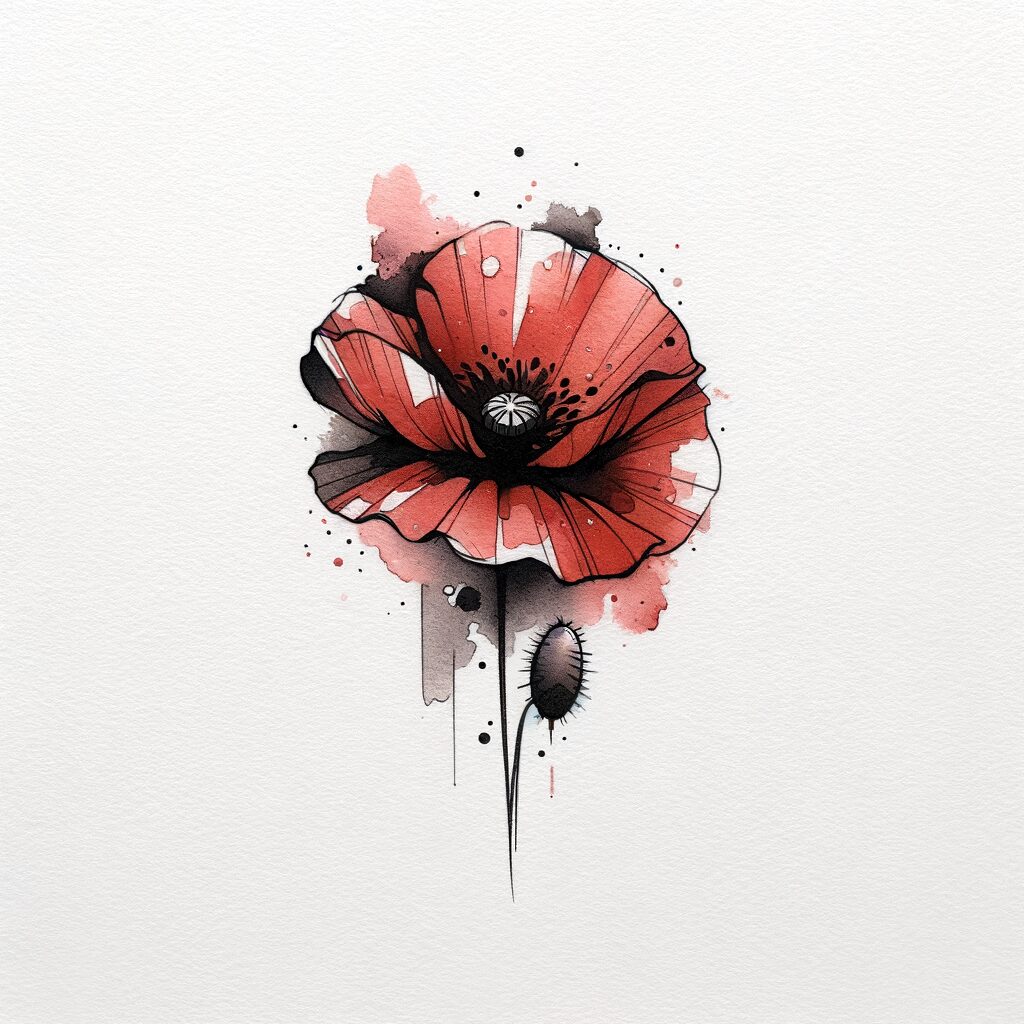
Surrealism Style:
- Correctly Identified AI: 51%
- Incorrectly Identified Human Designs as AI: 32%
- Not Sure: 17%
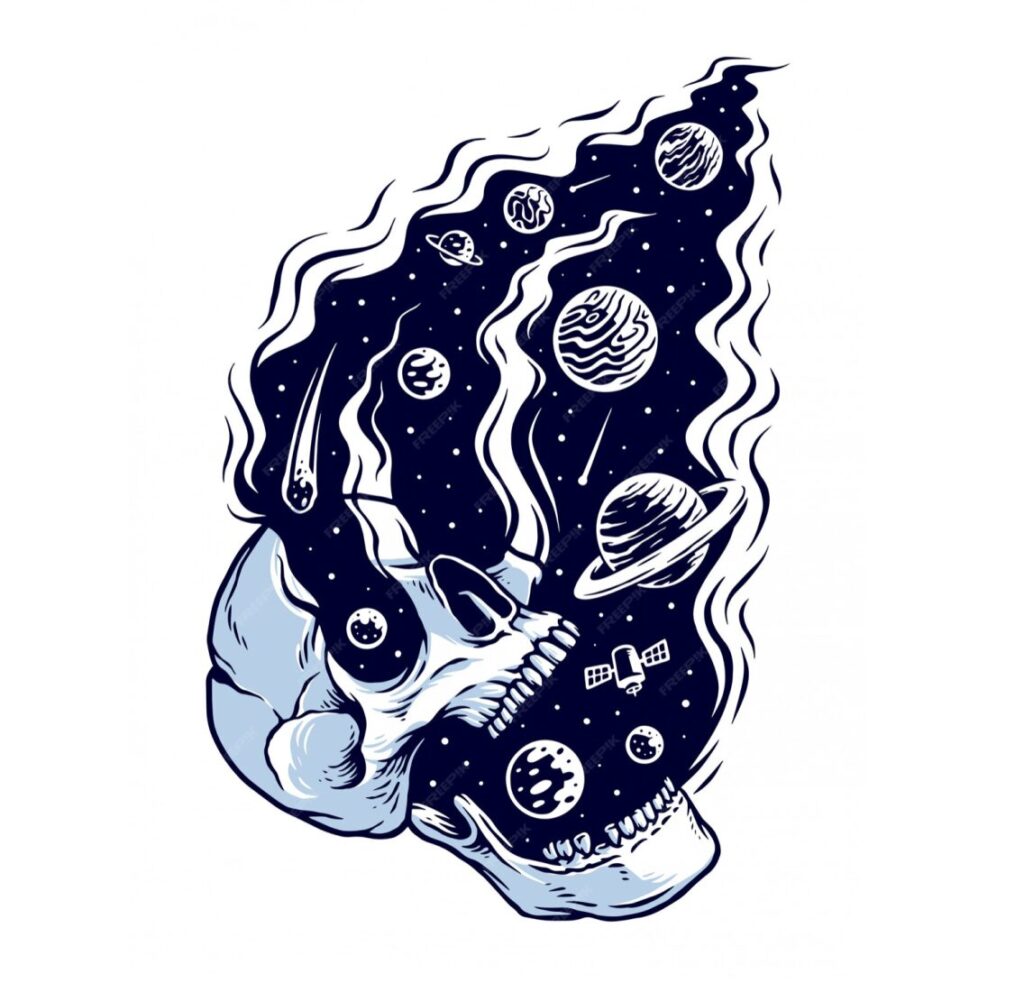
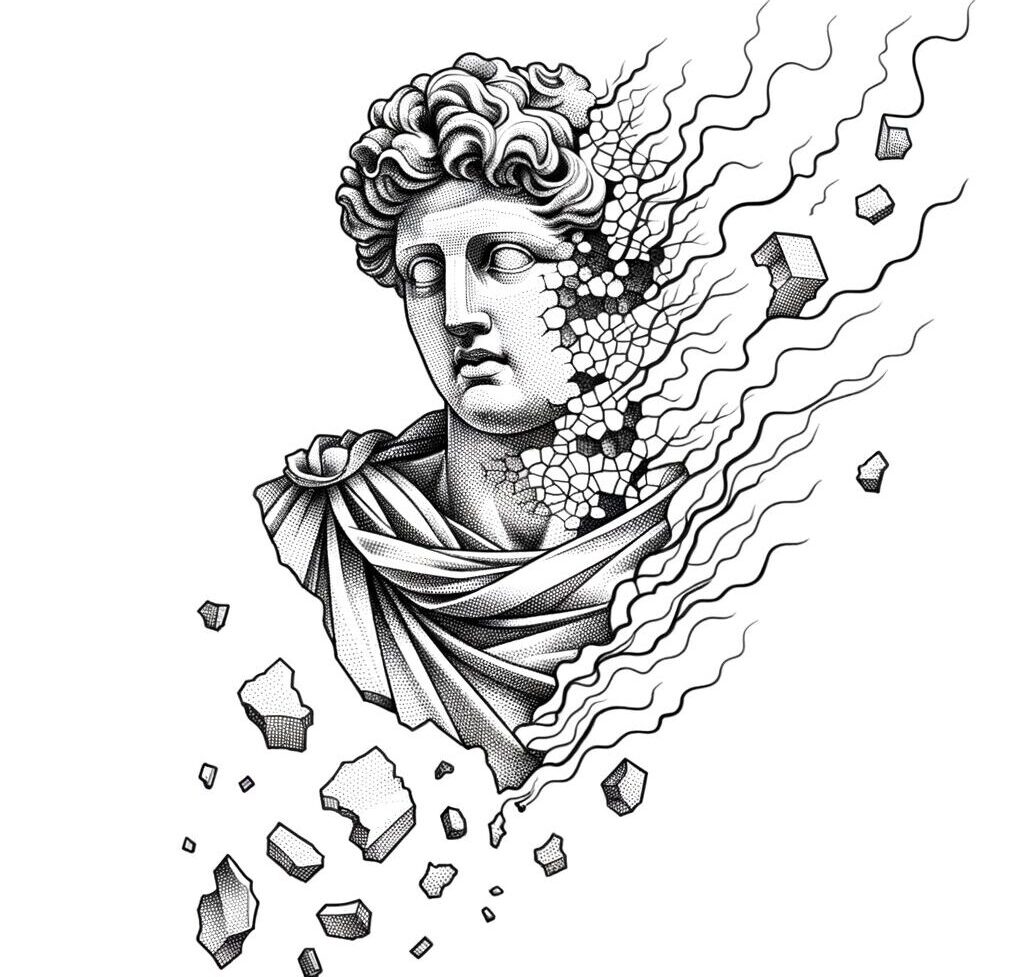
Japanese Style:
- Correctly Identified AI: 51%
- Incorrectly Identified Human Designs as AI: 32%
- Not Sure: 17%
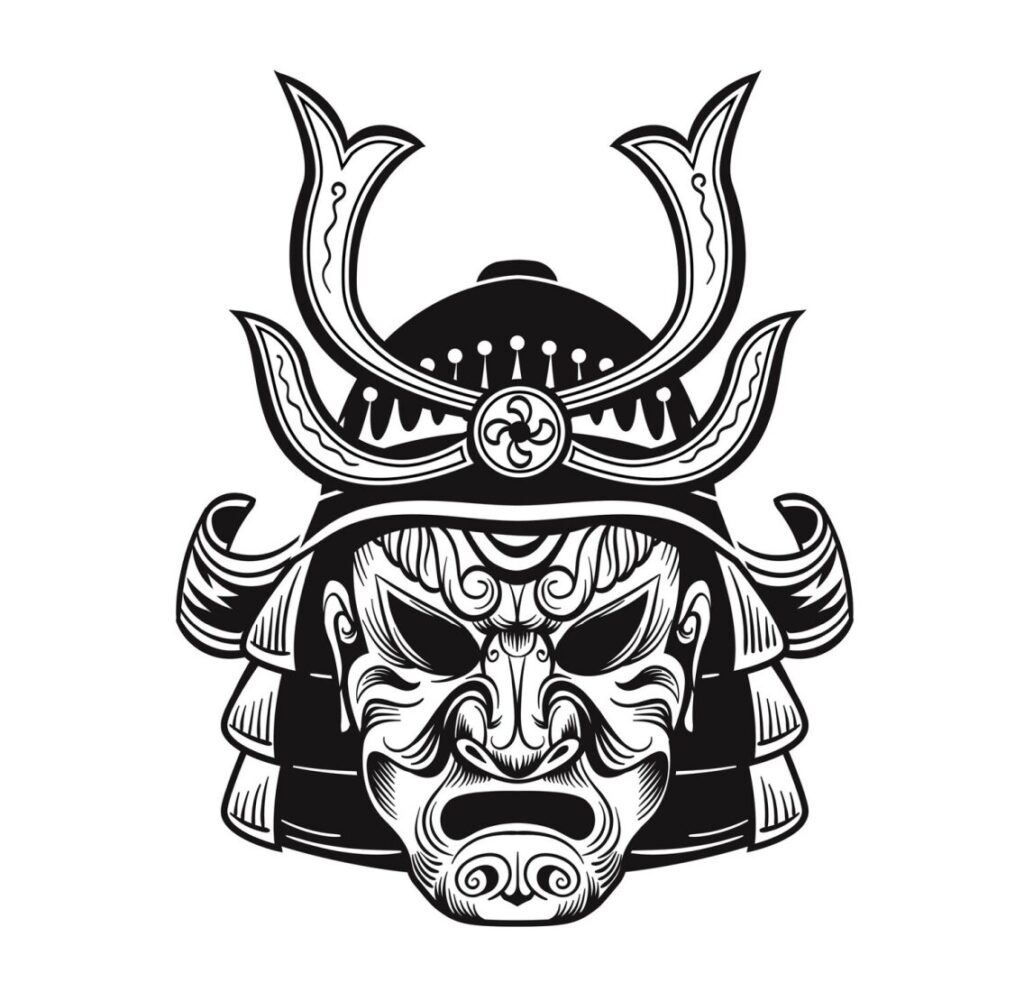
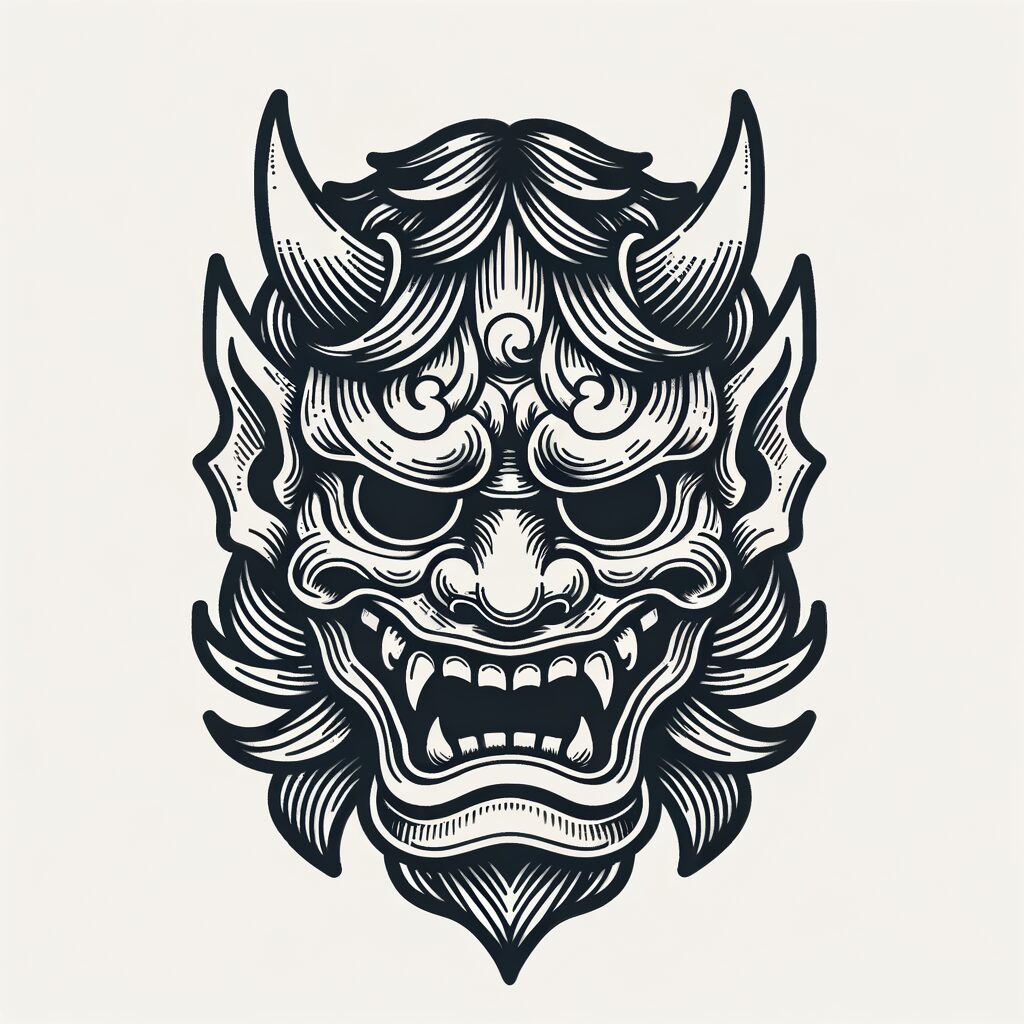
Minimalist Style:
- Correctly Identified AI: 51%
- Incorrectly Identified Human Designs as AI: 32%
- Not Sure: 17%
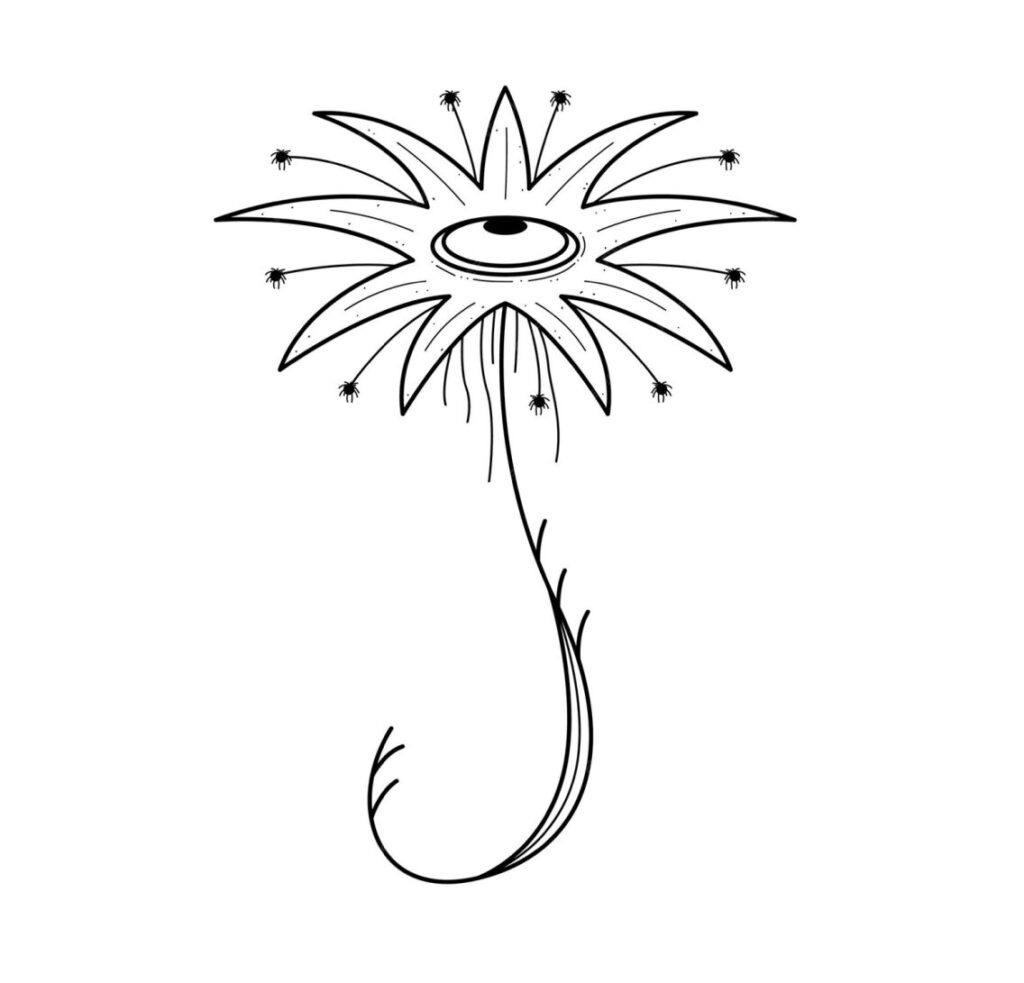
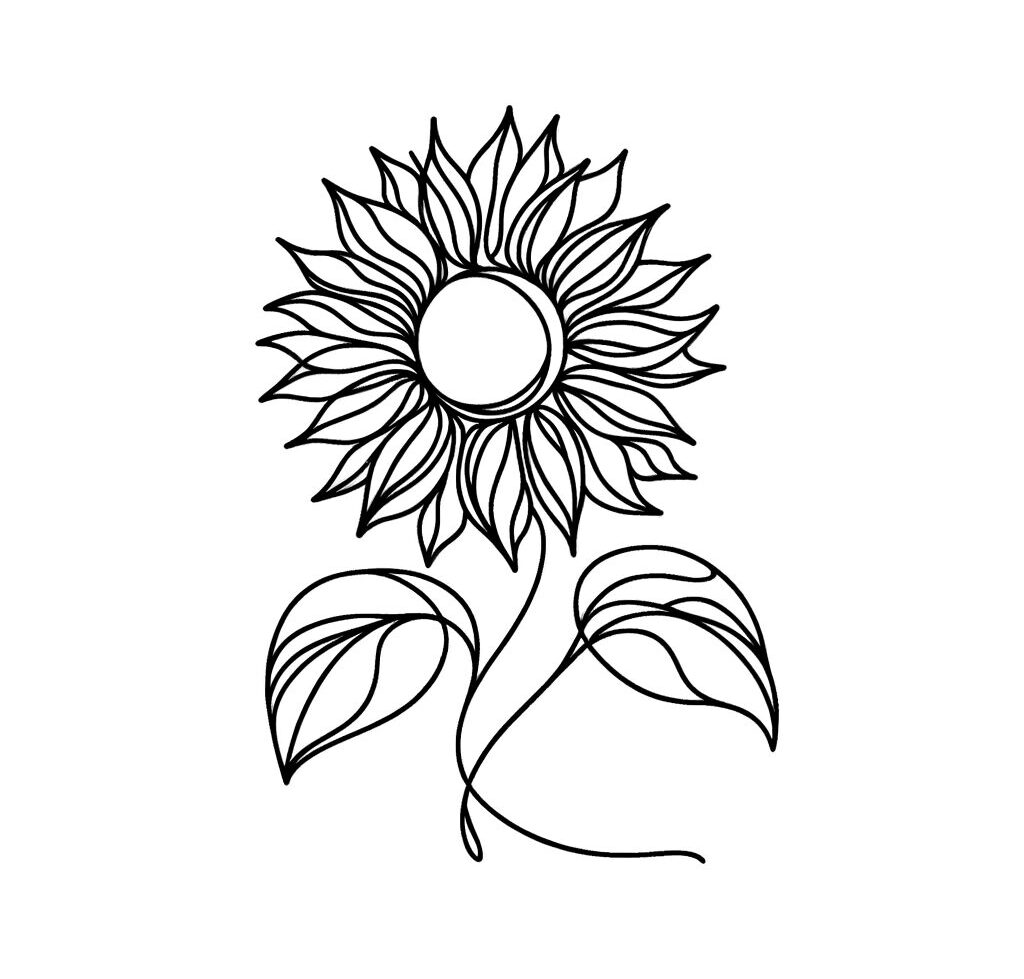
Retro Style:
- Correctly Identified AI: 51%
- Incorrectly Identified Human Designs as AI: 32%
- Not Sure: 17%
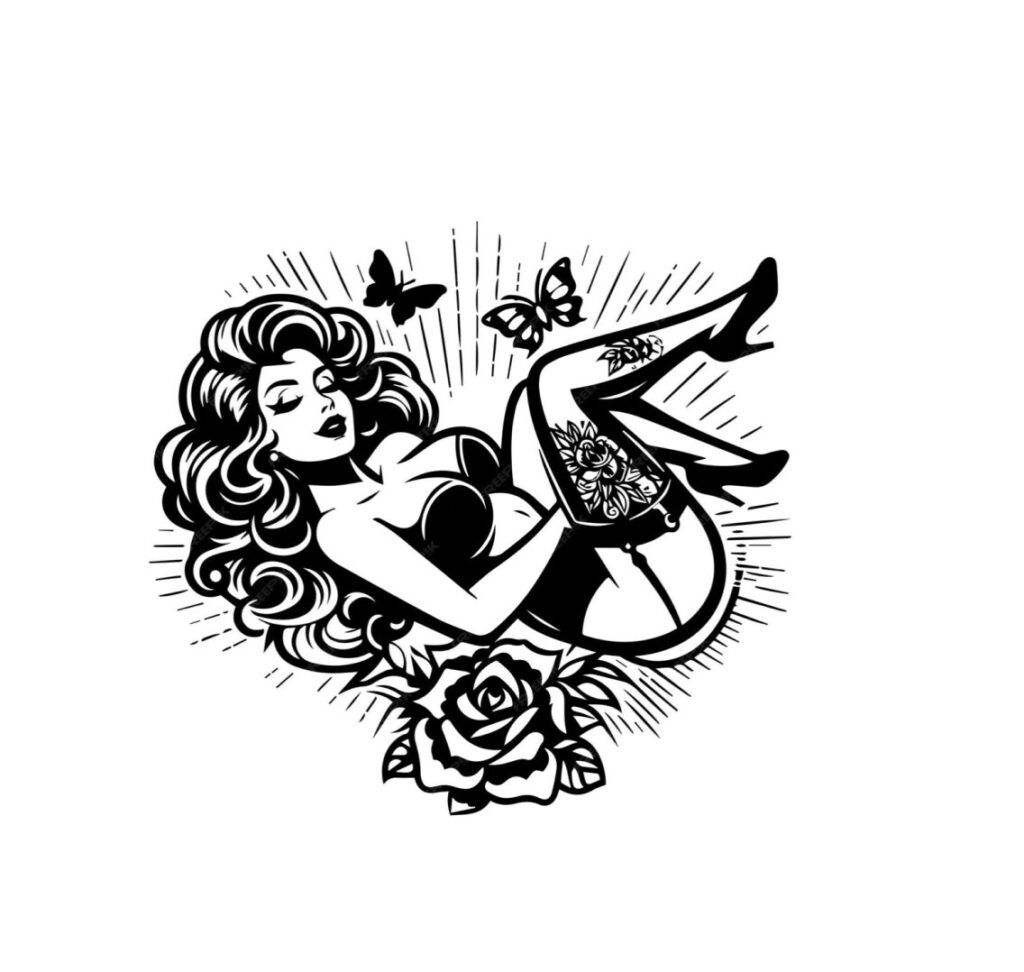
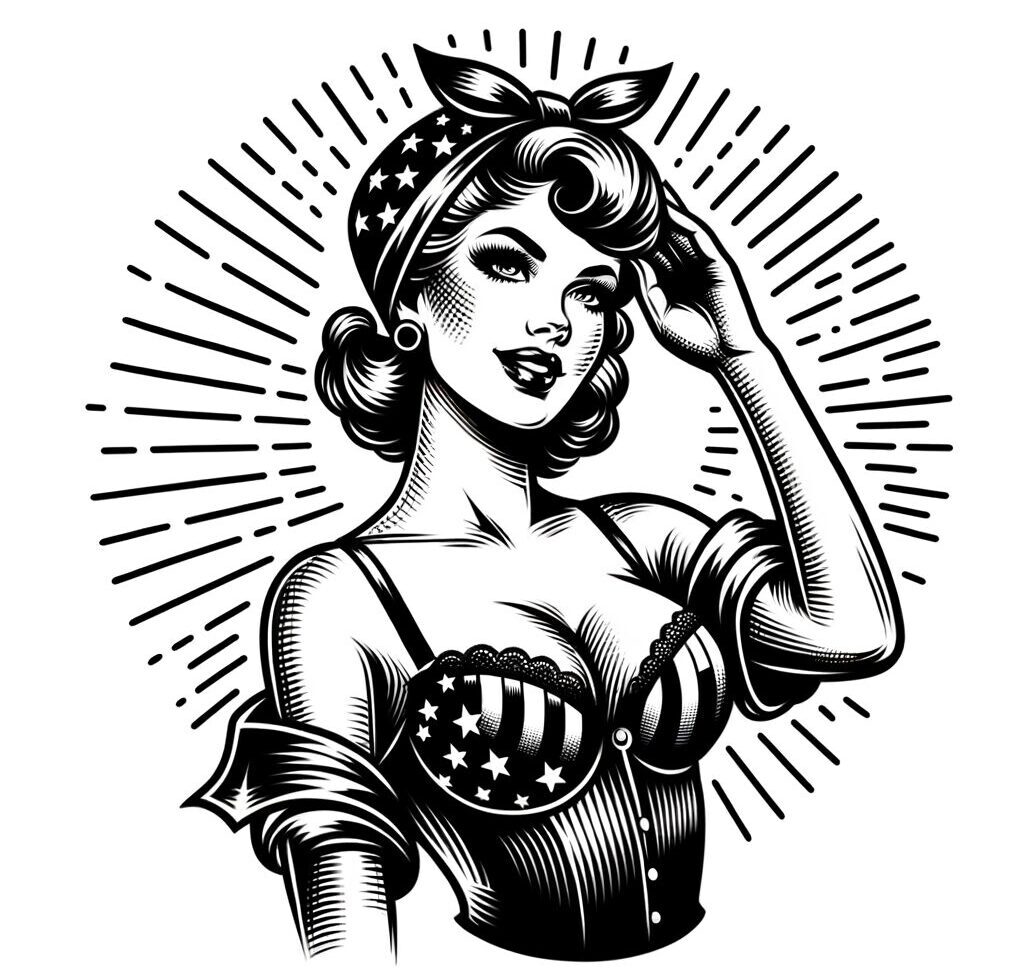
Traditional Style:
- Correctly Identified AI: 51%
- Incorrectly Identified Human Designs as AI: 32%
- Not Sure: 17%
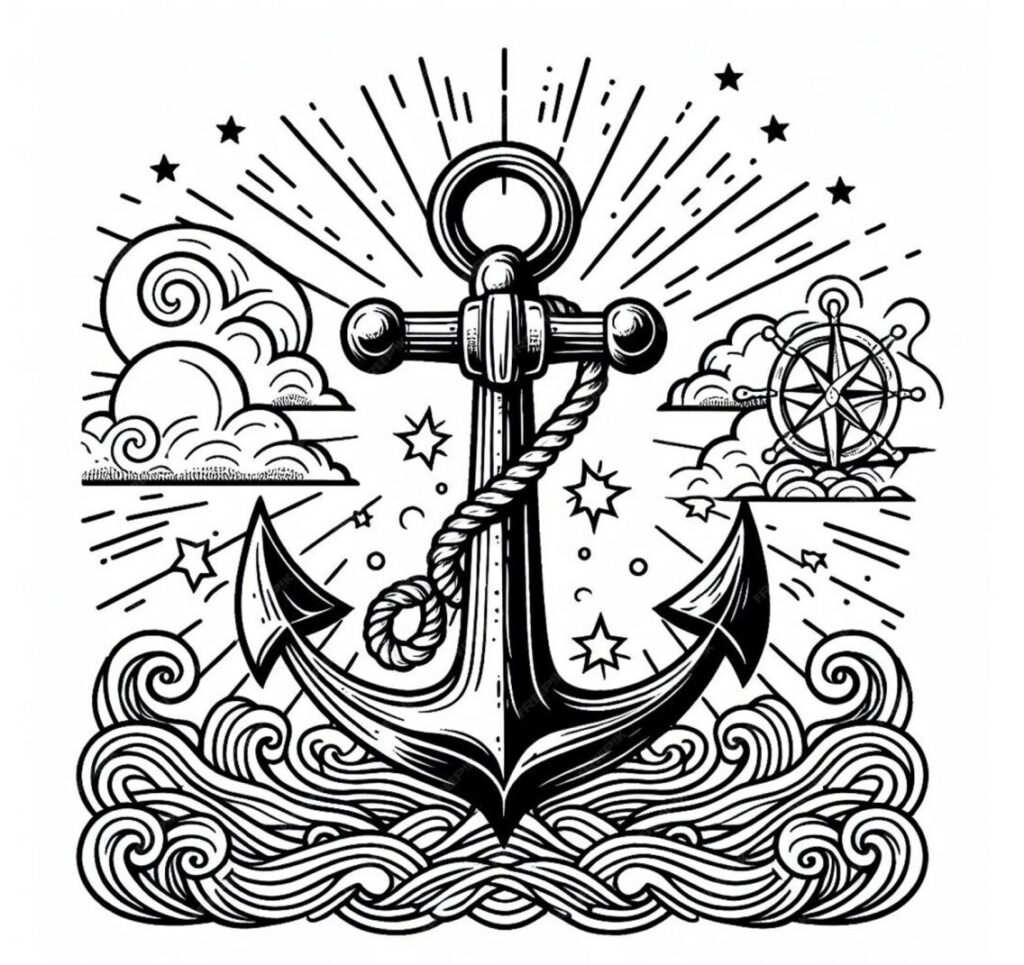
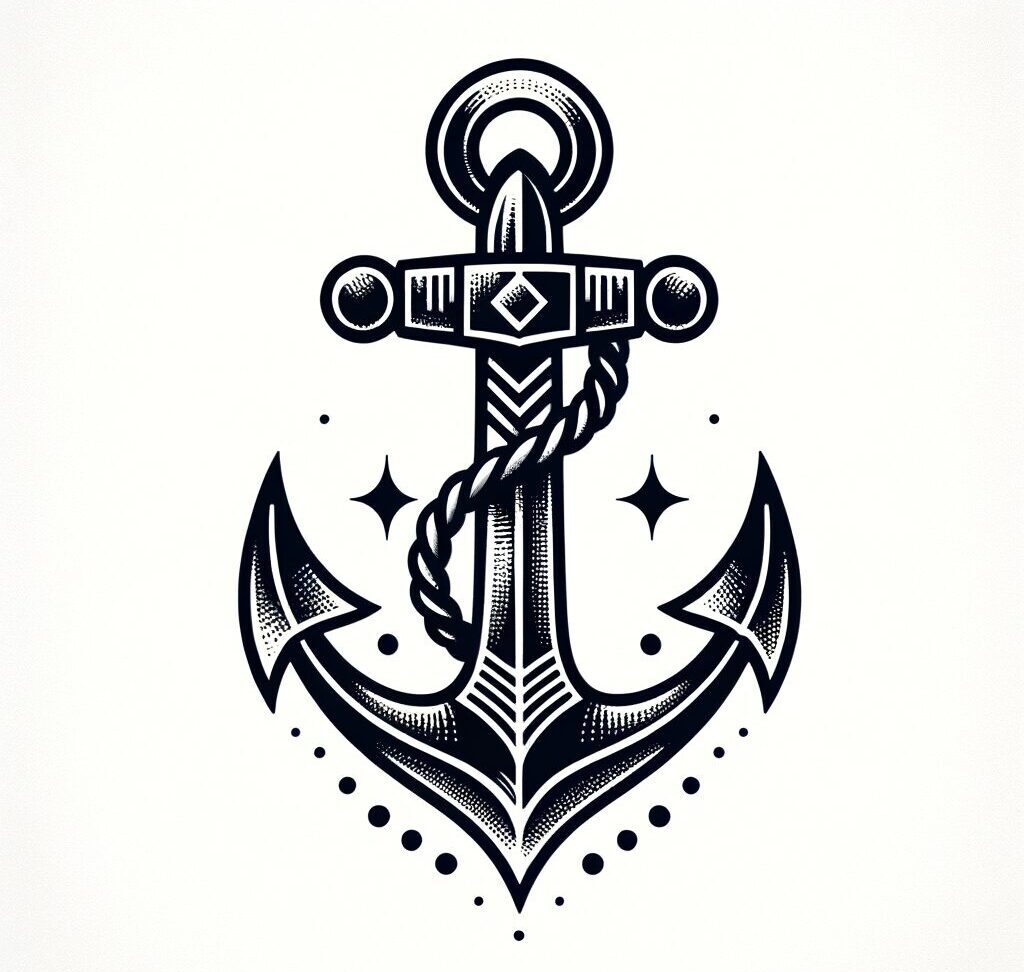
Fine-line Style:
- Correctly Identified AI: 51%
- Incorrectly Identified Human Designs as AI: 32%
- Not Sure: 17%

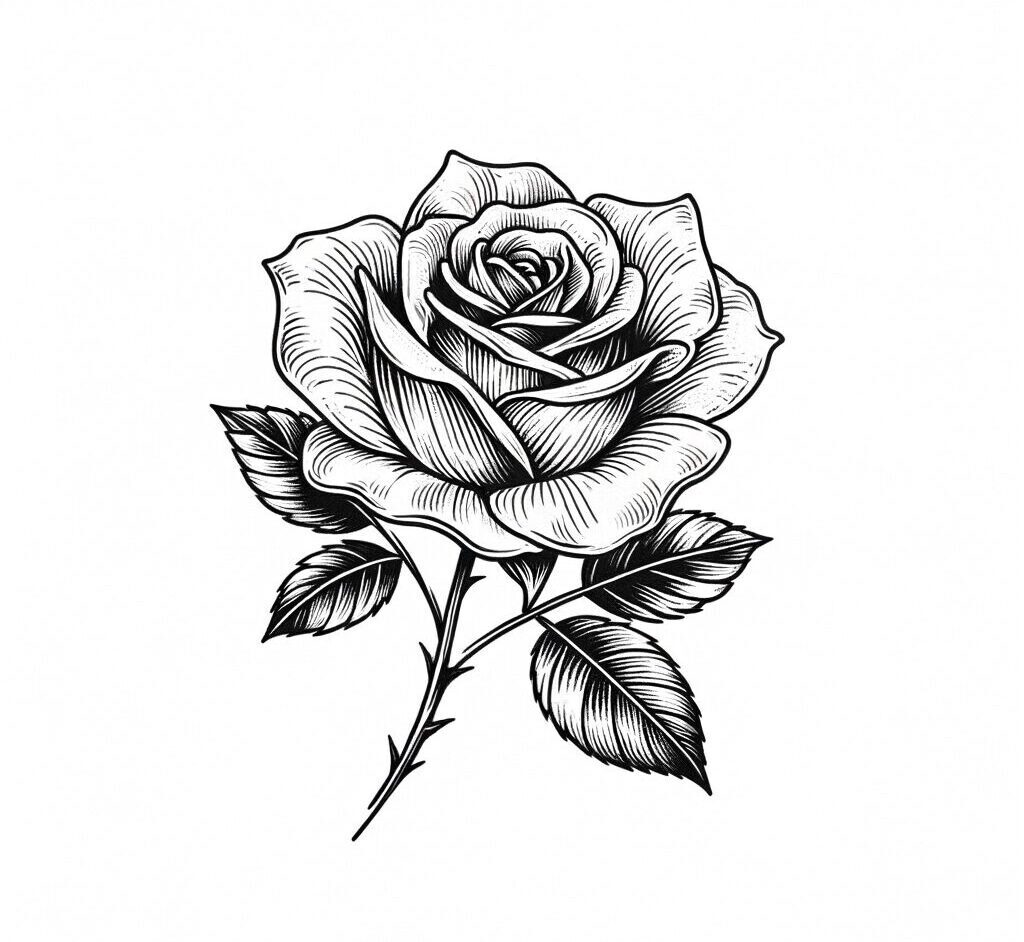
The Methodology Behind Our Artificial Intelligence Study
To ensure reliability and accuracy in our AI study, we designed our survey by carefully considering how the methods through which data was collected as well as the sample size, so we could have a systematic review of different tattoo images.
Objective:
Our goal was to assess whether people could correctly identify a tattoo designed by AI and future technologies versus art images created by human tattoo artists using traditional processes to ensure high quality for their clients.
Sample Size:
Our survey included 391 people from around the world so we could get an accurate sample. This ensured that are confidence level for the results were 95%, with a 5% margin of error.
Survey Design:
Every participant was shown 10 sets of different tattoo images. Each tattoo design grouping had one image that were AI generated tattoos and one created by human tattoo artists in the tattoo industry. We randomized the order in which each set of tattoo images were presented, so we could minimize bias. People were then asked to identify which tattoo images were generated by AI, or to choose “Not Sure” if they weren’t certain.
Data Analysis:
We then analyzed all the data from the AI study to determine what percentage of uncertain, incorrect and correct identifications were made for different tattoo images, across different styles of tattoos as well as important demographics such as age and gender.
Survey Tools:
We used a web-based platform to conduct the survey, which allowed us to reach a very diverse audience across the world, while also analyzing and processing the data in the most effectively way process.
The Blurring Line Between Human and AI Creativity
Our experiment suggests that future-looking technology such as AI has made significant strides in creating different types of tattoos that clients have a tough time distinguishing from tattoos created by peer reviewed tattoo artists. Only a little more than half of the people who participated in our survey across the world were able to accurately identify tattoos that were generated by AI, suggesting that the boundary that already exists between future technology and tattoo artists’ creativity is blurring at an increasing rate.
What these results suggest, then, is that there are important questions that remain about the future of AI tattoos and the quality of the pictures they generate compared to services that human tattoo artists provide their clients.
Tattoo artists need to take heed of these results, as they highlight how important it is for them to embrace tattoo design from an AI perspective, and how these future tools should be embraced as a complement to their art, rather than something that detracts from the quality of their work. If done correctly, AI generated tattoos can make for a seamless integration for clients in the future, helping with intricate details, skin tone and other articles that can meet the increasing demands of clients around the world.
At Tattoos.ai, we believe the future of the tattoo industry needs to be collaborative. AI tools can enhance already-existing technology tools such as Photoshop to expand the possibilities of what human tattoo artists can create, while still delivering high-quality ideas for their clients and also not losing the personal touch that all tattoo artists bring to the table.
The conversation about the role that AI can and should play in the creative process of tattoo design with tattoo artists is only expected to grow. There’s no denying the power that AI has, but it’s also important to realize how irreplaceable the human element that tattoo artists contribute is.
For the future, tattoo artists can embrace and explore the power of AI so they can harness the potential that AI can bring them, while also preserving the skill these artists have, the individuality that tattoo artists enjoy and the high quality results that they produce for all of their clients — no matter where they are in the world.